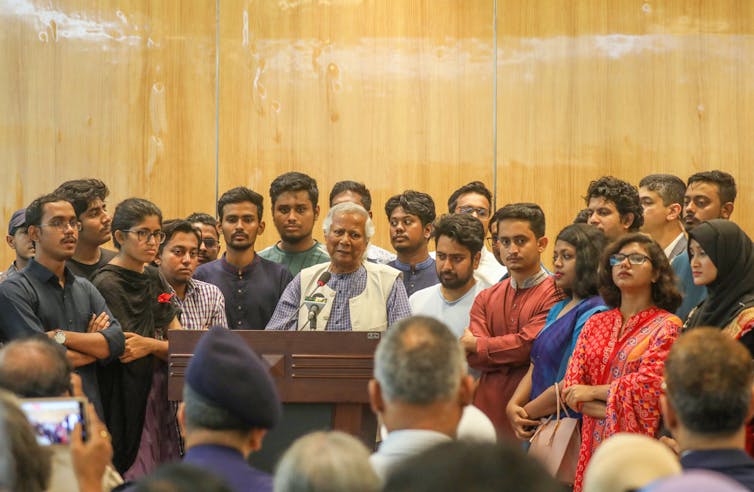Sheikh Hasina ruled Bangladesh with an iron fist for over 15 years. But on Monday August 5 she was forced to resign and flee the country as hundreds of thousands of people marched on the capital Dhaka and stormed her residence.
Until the very end, Hasina tried to hold on to power through the use of brute force. The final fortnight of her rule was marked by a violent crackdown on protesters that resulted in the deaths of 440 people.
What started as a non-partisan student movement for the removal of a system that allocated 56% of government jobs through quotas turned into a popular uprising that overthrew a dictator.
Bangladesh: how the prime minister, Sheikh Hasina, lost her grip on power
The country’s president, Mohammed Shahabuddin, the armed forces and political parties are now in the process of establishing a temporary “caretaker” government. The government will be led by Nobel laureate Muhammad Yunus, who Hasina’s government had subjected to a longstanding campaign of judicial harassment for announcing plans to set up a “citizen power” political party in 2007.
Other members include a former governor of the Bangladesh Bank, Salehuddin Ahmed, as well as human rights activists, lawyers, academics and representatives from the student movement, the army and minority groups.
Monirul Alam / EPA
Bangladesh’s first caretaker government was formed in 1991 to oversee the transition to democracy after the fall of Hussain Muhammad Ershad’s military dictatorship. The arrangement was widely viewed as a success and was formalised through a constitutional amendment that provided the basis for caretaker governments to oversee elections in 1996, 2001 and 2006.
But in 2011 Hasina’s parliament changed the constitution and abolished the caretaker system. The decision led opposition parties to boycott subsequent elections, sealing Bangladesh’s transition to a one-party state.
Now is a truly critical time for the country. On the one hand, there is hope and optimism that the new generation of leaders drawn from this uprising will set the country on a path to inclusive democratic institutions that safeguard the rights and freedoms of all its citizens.
On the other, there are concerns that conservative religious parties, including he largest Islamic party in Bangladesh, Jamaat-e-Islami, may capitalise on the power vacuum to stoke division. This could set Bangladesh on a trajectory where the rights of religious and ethnic minorities, women and LGBTQ+ people may be compromised.
Cause for concern
More than 90% of Bangladesh’s population is Muslim. They traditionally practised a moderate version of Islam that drew heavily on spiritual Sufi traditions.
But over the years Saudi Arabia has promoted a theocratic “Wahabi” Islam in Bangladesh by funding mosques, madrasas and Islamic NGOs. And the country’s diaspora in the UK, who originate predominantly from the Sylhet region in north-east Bangladesh, have formed a global Muslim identity and retain strong ties with the area.
Hasina’s regime has also brutally suppressed and unlawfully detained hundreds of members of religious opposition parties. In 2013, for example, at least 61 people were killed in clashes with security forces in Dhaka at a protest organised by the group Hefazat-e Islam to call for stronger Islamic policies.
It is possible that the victimisation of religious parties under Hasina may inadvertently have increased their popular support. Since independence from Pakistan in 1971, the vote share of Jamaat-e-Islami had been declining. In 2008, the year the party last contested an election, it won a mere 4.7% of the vote and only two out of the 300 elected seats in parliament.
This time gap makes it difficult to gauge the current level of support for Bangladesh’s religious parties. But following Hasina’s departure, there have been widespread reports of looting and vandalism, targeting the homes of some ethnic minority members of her Awami League party. Members of the public from religious and ethnic minorities have also reportedly been attacked – though misinformation has been widespread.
As this news spread, people from across the country mobilised to protect minority groups. Images circulated on social media of students, imams of local mosques and members of the public guarding temples and the property of minority communities. The hashtags #HindusAreSafeInBangladesh and #MinoritiesAreSafeInBangladesh were both trending on X.
Thousands of volunteers have since helped clean up sites and repair the damage. Students from mainstream education worked together with those from Islamic schools to clean up the area around the national parliament building. And student leaders even tracked down and returned 40 firearms that were stolen from the parliament armoury.
Monirul Alam / EPA
Inspiring though these acts may be, the question remains as to how the Bangladeshi state can be reinvented to protect the rights of all its citizens. The events of the past month have shown just how politicised Bangladesh’s key institutions have become.
The judiciary flip-flopping on job quotas at the whim of the government – they were reinstated recently and subsequently peeled back having been scrapped in 2018 – set off the initial protests. And universities failed to protect student protesters against violent attacks by members of the Awami League’s student wing.
Protesters were also subject to excessive force, abduction and torture by law enforcement agencies. Assault rifles, grenade launchers and gunfire from police helicopters were often used on unarmed protesters to devastating effect.
The interim government will need to undertake a careful and comprehensive overhaul of these institutions to protect the civil liberties and human rights of every Bangladeshi citizen, including its minorities.
It will need to safeguard the right to dissent and create an atmosphere where parties are not tempted to stoke religious and ethnic divides. Only by initiating these reforms will future government’s not be empowered to repeat the atrocities of the Hasina regime.

